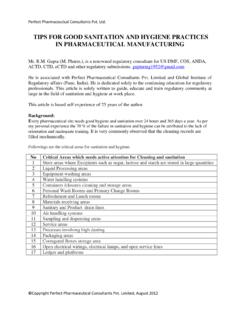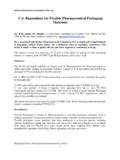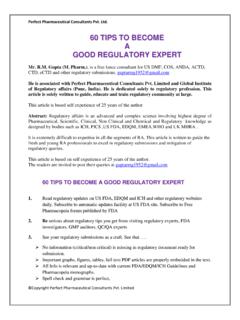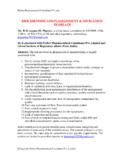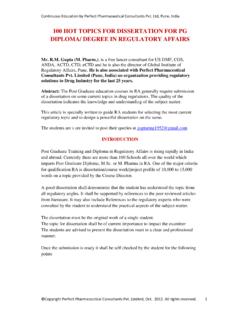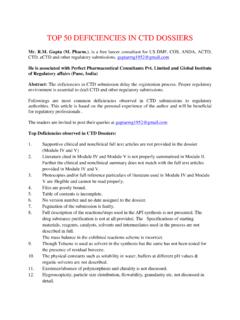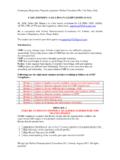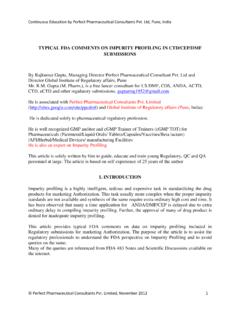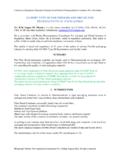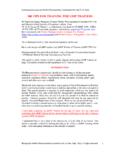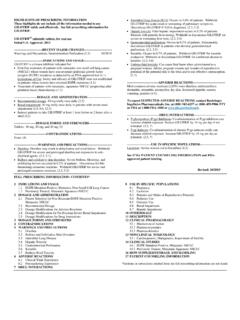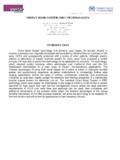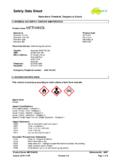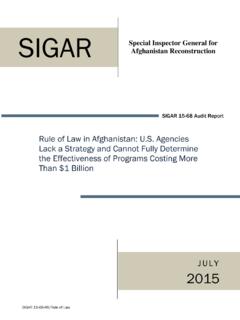Transcription of US DMF TYPE III FOR PLAIN AND PRINTED …
1 US DMF TYPE III FOR PLAIN AND PRINTED flexible lamination FILMS FOR blistering , STRIPPING AND POUCHING Mr. Gupta (M. Pharm.), is a free lance consultant for US DMF, COS, ANDA, ACTD, CTD, eCTD and other regulatory submissions. He is associated with Perfect Pharmaceutical Consultants Pvt. Limited and Global Institute of Regulatory affairs (Pune, India). He is dedicated solely to regulatory profession. This article is solely written to guide, educate and train regulatory community at large. This article is based self experience of 25 years of the author in serving flexible packaging Industry for meeting their US DMF Type III Registrations and Facility Audit Summary: The flexible packaging materials are largely used in Pharmaceuticals for blister packaging of tablets and sachet packing of dispersible powders. Almost 75 % of oral tablets and powders are packaged in US are packaged in flexible materials.
2 US 21 CFR and USP 34 NF 29 have prescribed a set of specification for controlling the quality of such materials. US FDA also offers registration of flexible packaging materials under US DMG Type III. A very large number of Indian Companies have upgraded their site to meet US FDA requirements and have applied for US DMF. This article is written to guide flexible Packaging material manufacturers/exporters/processors to know current US FDA requirements and to upgrade their facilities accordingly The author has person experience for filing US DMF Type III for Packaging materials for large number companies including HINDALCO. INDEX No Heading Page 1 Introduction 2 What are the basic requirements for flexible Packaging materials as per US FDA? 3 What is US DMF Type III for flexible Packaging materials? 4 Why you shall file DMF III for flexible Packaging materials? 5 What are your obligations after Filing US DMF for flexible Packaging materials?
3 6 What are the Risks involved in self filing US DMF flexible for Packaging materials? 7 What critical information you shall include in US DMF Type III for flexible Packaging materials? 8 What critical inprocess quality tests shall be included in DMF for flexible Packaging materials? 9 What are the services usually outsourced on US DMF Type III for flexible Packaging materials? 10 Conclusion 11 References Introduction: flexible Packaging in context to Pharmaceuticals is non-rigid packaging structures used to package and protect various drug products such as tablets, capsules, powders for medical use. flexible packaging covers materials that have undergone a conversion process including printing, lamination , coating and extrusion, and can involve different substrates such as plastic films, paper and foil. flexible pack types include plastic bags, wrapping films, lidding films, aluminum foil laminates; foil lidding, blister packaging, foil bags and sachets.
4 flexible packaging films can be made from: * Single materials such as PE, PP, polyester or PU * Multiple materials by coating, laminating or co extruding with the other materials The most common forms of flexible packaging are the strip package, blister package and the pouch. A blister package usually consists of a lidding material and a forming film. The lidding material is usually a laminate which includes a barrier layer ( , aluminum foil) with a print primer on one side and a sealing agent ( , a heat-sealing lacquer) on the other side. The pouch is usually sealed from 3 sides and one side is kept open for filling and sealing thereafter. The sealing agent contacts the dosage form and the forming film. The forming film may be a single film, a coated film, or a laminate. Leak testing is usually performed on flexible packages as part of the in-process controls According to one estimates, more than two-thirds of all medicines are delivered orally and are therefore likely to be packed in blisters/pouches/strips/bags The most common examples of flexible Pharmaceutical packaging materials are: Aluminum Foil, BOPP (biaxial oriented polypropylene), LDPE (low-density polyethylene) LLDPE (linear low-density polyethylene) OPP (oriented polypropylene) PA (polyamide) PE (polyethylene) PET (poly ethylene terephthalate), PP (polypropylene), PVC (poly vinyl chloride) PVDC (polyvinylidene chloride), as used singly or in laminate form.
5 A. What are the basic requirements for flexible Packaging materials as per US FDA ? The product shall be manufactured as per cGMP Guidelines provided under directive 21 CFR parts 11. The products used for as primary packaging of pharmaceutical products shall be manufactured under clean room conditions meeting Class 1, 00,000 cleanliness standards. 1. The container shall meet all requirements under 21 CFR Direct Food Contact and physical tests in accordance to latest USP <661>: 2. The container shall protect the contents from environmental hazard and external influences ( moisture, light, oxygen and temperature variations) during its entire life time beginning from packaging, transportation, handling and storage until use. 3. It shall not be composed, in whole or in part, of any poisonous or deleterious substance which may render the contents injurious to health 4.
6 It shall not be reactive, additive, or absorptive so as to alter the safety, identity, strength, quality, or purity of the drug beyond the official or established requirements. 5. The integrity of the flexible material must be met throughout the whole of the intended shelf-life of the product. The materials shall be conditioned to the 23 C and 50% RH before conducting any QC/QA tests. 6. Recycled starting material or finished product is mostly not allowed. 7. The product shall be supported by Certificate of Analysis (COA) or Certificate of Certification (COC) from the component supplier and the performance of an appropriate identification test, provided the supplier s test data are periodically validated (21 CFR (d)(3)). 8. All test methods shall be fully described. 9. If a batch is to be accepted based on a supplier's COA or COC, then the procedure for supplier validation should be described.
7 The data from the supplier s COA or COC should clearly indicate that the lot meets the applicant s acceptance criteria. 10. Dimensional information shall be provided via a detailed schematic drawing complete with target dimensions and tolerances 11. Description of the quality control measures used to maintain consistency in the physical and chemical characteristics of the material. 12. A complete description of the process and its validation should be provided. What is US DMF Type III for flexible Laminates? It is a detailed information PLAIN and PRINTED flexible lamination Films for blistering , stripping and Pouching and other packaging materials required in Pharma Industry. DMF shall include detailed information in the prescribed format regarding Identification, intended use, components, composition, control methods, toxicological data, method d of manufacture, release specifications, safety of color additives, compliance with applicable environmental laws, stability and other information depending on the nature of the product.
8 Further, it shall also include necessary admin information, transmittal letter and undertakings. Why you shall file DMF III for flexible Packaging materials? It is a prestigious quality Accreditation Your company name is displayed at US FDA website and your good will enhanced Your packaging Materials are preferentially required by exporters of Pharmaceuticals Your buyer gets legally bound with FDA to source all his packaging material from you and can not replace you easily It improves your quality system It raises the moral of your management and a staff It established cGMP at your works It keeps your major competitors away You get enlisted in top quality vendor for products manufactured by at your end Your company gets associated and recognized by US FDA You become legally authorized to supply your packaging material to pharmaceutical companies exporting to US Your company is reference to FDA The drug manufacturer references the Drug Master File in its NDA Does FDA protects the information displayed a DMF with FDA?
9 FDA fully protects proprietary information. It is a timely, seamless review of information referenced by a number of applicants at one time What are your obligations after Filing US DMF? You shall upgrade your quality system and keep it current with GMP NORMS? You must file an annual report about the changes in manufacturing facility What are the Risks involved in self filing US DMF? If the submission is incomplete or inadequate, it will be returned to the submitter with a letter of explanation from the Drug Master File Staff, and it will not be assigned a DMF number. If there are deficiencies in the information provided in a DMF, a letter describing the deficiencies is sent to the DMF holder. However, if DMF is filed through an experienced consultant, the risk involved is negligible. It shall be cleared in the first attempt without any adverse report. What technical information you shall include in US DMF Type III? Include the test reports and information as per below.
10 The routine tests are marked with * The tests required at regular intervals (3 to 6 months) are marked with ** No Requirements Purpose 1 Material Name, product code, brief description, Materials of construction and the address of the manufacturing site shall be provided Material and site identification 2 Test Reports on Polymeric materials and auxiliary substances used in manufacturing flexible laminates/. To ensure suitability of each material(Suppliers Test report acceptable) 3 Description of the manufacturing process and operations A description of the quality control measures Description of the acceptance, in-process, and release controls To assess chemistry manufacturing and Control Procedures 4 Engineering Drawing To ensure length, width, thickness and arrangements of different polymeric layers in laminated material 5 Identification of individual Polymer Film by IR spectrophotometer To confirm the claimed identity of Polymer monitor consistency in composition 6 Identification of each layer of the laminate by combination of FTIR and Microscopy To confirm the claimed composition of the laminate 7 Identification of pigments and colorant such as Titanium dioxide by IR To confirm claim identity of colorant used 8 Identification of solvents retained after printing and lamination by To confirm that the product is free from solvents 9 Sealability.
